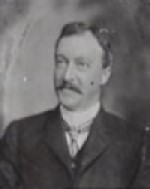Robert Hargreave Brodrick was born in Macclesfield, Cheshire, in 1860, the son of Robert Brodrick, a well-to-do silk manufacturer. At the age of 16 years Robert H. was indentured to an architect, James Fraser, of Leeds, and in that city he saw the social problems arising from a crowded urban environment. After finishing his studies in several other English cities, Robert came to New South Wales in 1882, with some experience of city architecture. The following year he began work with the Sydney Municipal Council as a draftsman in the City Architect’s Department. In twelve years he became head of the Department, City Architect and Building Surveyor.

In 1896 Robert married Emily Jane Maher, aged 23 years, at All Saints’ Church of England, Petersham. Emily, the daughter of William and Mary Maher, was a teacher at Darlington School. One son and four daughters were born to Emily and Robert between 1897 and 1912. They lived in the Petersham-Marrickville area until 1904 when they moved to Beecroft. Robert had purchased one acre of land in Cheltenham, on the corner of Beecroft Road and Mason Avenue, and there he built their home, ‘Kainga’, to his own design. The house, facing Mason Avenue, was of English appearance in the modern style and stood in a large garden. Robert loved the nearby bushland and often took his family to picnics and walks through it.[1]
Photo c1905
During his early years in Cheltenham Robert took part in local affairs, being Secretary of the Beecroft Progress Association from 1909 to 1911, a member of the Parents’ and Residents’ Committee and St John’s Church committee. He was a trustee of Cheltenham Park (1913) and was a foundation member and Secretary of the Cheltenham Recreation Club. In 1924 he was the first Rector’s Warden of St Andrew’s Church of England, Cheltenham.[2]
Robert Brodrick held a remarkable record of 45 years in the one municipal department and his architectural work was important in reshaping the City of Sydney. Bubonic plague in the first years of the 20th century and an awareness of the unhealthy residential areas of the inner city aroused a protracted and often bitter debate on whether the cottage or the tenement, the packed city or suburbia, was the most suitable home for the urban worker.
In 1914, called upon to design homes for 75 families in Chippendale, Robert Brodrick planned his building (the Strickland Building) in broken blocks with recessed balconies and bay windows for extra light. In 1927 he designed the Alexandra dwellings in Camperdown, 22 large semi-detached flats and one shop with a residence in two storeyed separate buildings. His designs for inner-city housing were intended to gain as much light, air and privacy as possible within a confined space. There was frequent opposition to his ideas on public housing. During his long career in the Public Service he saw reformed plans benefiting the working man introduced under State Labor governments, but shelved under non-Labor governments.
Under the innovative Local Government Act of 1908 the City Architect held authority to regulate all new building with regard to height, size, design and materials. Robert Brodrick’s aim was to give the city a more cohesive and improved appearance. The elements of his work were described by a local newspaper as ‘stateliness and reliability’. Among the impressive list of public works he designed were: 300 electricity substations in the city and suburbs, each of different style to suit its immediate environs (at a time when bank and Post Office branches were recognisable by their uniformity), the Pyrmont and Woolloomooloo Baths (1902 and 1908), the Pyrmont and Bunnerong Power Houses (1904 and 1927-1928), the large municipal markets at the Haymarket built on cleared slum housing (1909-1915) and the alterations to the Queen Victoria Building for the Sydney Municipal Library (1918).[3]
On his retirement in 1928 at the age of 68 years, Robert Brodrick spent his days in the quiet of Cheltenham, frequently playing bowls at the Recreation Club. He was still very active, and one of the first things he did on retirement was to gain his driver’s licence and buy himself a red sports car, much to the concern of his family.
Emily Brodrick had been involved with the Parents’ and Residents’ Committee while their children were at Beecroft Public School. During the war years she was on the committee of the local Red Cross branch, for many years until 1950 being Honorary Treasurer when she retired from the position at the age of 77 years. She was also for a long time Superintendent of St Andrew’s Sunday School, Cheltenham.[4]
Robert Brodrick died at his home in 1934 aged 74 and was buried in Northern Suburbs Cemetery. Emily remained in Cheltenham until her death in 1959.
